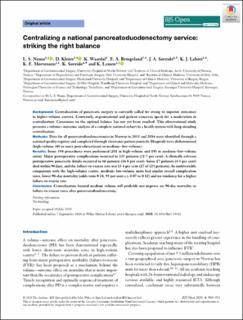Centralizing a national pancreatoduodenectomy service: striking the right balance
Nymo, Linn Såve; Kleive, Dyre; Waardal, Kim; Bringeland, Erling Audun; Søreide, Jon Arne; Labori, Knut Jørgen; Mortensen, Kim Erlend; Søreide, Kjetil; Lassen, Kristoffer
Journal article, Peer reviewed
Published version

Åpne
Permanent lenke
https://hdl.handle.net/11250/2753329Utgivelsesdato
2020Metadata
Vis full innførselSamlinger
- Department of Clinical Medicine [2066]
- Registrations from Cristin [9791]
Sammendrag
Background
Centralization of pancreatic surgery is currently called for owing to superior outcomes in higher-volume centres. Conversely, organizational and patient concerns speak for a moderation in centralization. Consensus on the optimal balance has not yet been reached. This observational study presents a volume–outcome analysis of a complete national cohort in a health system with long-standing centralization.
Methods
Data for all pancreatoduodenectomies in Norway in 2015 and 2016 were identified through a national quality registry and completed through electronic patient journals. Hospitals were dichotomized (high-volume (40 or more procedures/year) or medium–low-volume).
Results
Some 394 procedures were performed (201 in high-volume and 193 in medium–low-volume units). Major postoperative complications occurred in 125 patients (31·7 per cent). A clinically relevant postoperative pancreatic fistula occurred in 66 patients (16·8 per cent). Some 17 patients (4·3 per cent) died within 90 days, and the failure-to-rescue rate was 13·6 per cent (17 of 125 patients). In multivariable comparison with the high-volume centre, medium–low-volume units had similar overall complication rates, lower 90-day mortality (odds ratio 0·24, 95 per cent c.i. 0·07 to 0·82) and no tendency for a higher failure-to-rescue rate.
Conclusion
Centralization beyond medium volume will probably not improve on 90-day mortality or failure-to-rescue rates after pancreatoduodenectomy.
